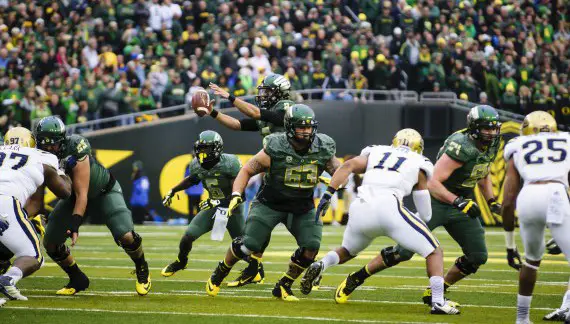It would be kind to say that a four-team playoff is an improvement over the BCS Championship that it replaced. But what we have isn’t quite the same as trying to fit a square peg into a round hole. It’s more like trying to fit five square pegs plus a few splinters into four round holes. What could go wrong? The four-team college football championship series is the subject of this week’s Three-and-Out.
1. Take five “power” conferences. Add a couple of independents to the mix. Then throw in a few upstart “mid-majors.” Sounds like a recipe for disaster? As the infomercial hawkers say, “But wait, there’s more! Order now and you will receive one of the major conferences wanting not one, but TWO spots!” And their teams are lined up, waiting for any excuse to make it happen.
As we know, the four teams with the inside track at this point are Florida State, Oregon, Oklahoma and Alabama. So far, so good. But the SEC 12 vultures — Auburn and Texas A & M, for now — are perfectly positioned to move into the top four if anybody slips up. The Pac-12 and Big 12 have UCLA and Baylor, respectively, in position to work their way into the top four if Plan A (Oregon and Oklahoma) fails, and independent Notre Dame is also in the mix.
Florida State has Notre Dame as the only ranked team left on its schedule. If FSU gets past the Irish and takes care of business, they are in. If Notre Dame beats Florida State, they would still have to get past Stanford, Arizona State and USC to be assured of bumping a one-loss Pac-12 team.
A lot can change, but as things now stand, if Alabama, Oregon or Oklahoma takes a hit, a team from its own conference will simply take its place, if (and this is a big “if”) in the case of the Pac-12 and Big 12, that team remains undefeated. But, mark my word, Auburn, aTm and even Ole Miss at No. 11 are the vultures, circling the sky, waiting for FSU to lose, or for the Pac-12 or Big 12 to fail to produce an undefeated champion, ready to make it a two-team SEC final four.
2. The Pac-12 and B1G’s chances. The Pac-12 has lost face with a few nonconference games that haven’t gone so well. And it hasn’t helped that teams that stunk it up out of conference played tough against highly regarded in-conference teams. Think WSU losing to unranked Rutgers and Nevada and then playing Oregon tough and beating previously undefeated Utah, or USC beating Stanford and then being humiliated by Boston College before blitzing the Beavers. UCLA’s slim wins over less-than-stellar competition out of conference also have not helped. Everybody in the Pac-12, including Oregon, is going to need some help with so much as one loss.
If the Pac-12 has lost face, what the B1G has lost in its nonconference games is on the other side of the body and about three feet lower. Five power conferences, four playoff spots: At least one conference gets left out, no way around it. At this point, the highest ranked B1G team is Michigan State, and it has already lost to Oregon. If the system ousts Oregon, probably Michigan State gets ousted by association and we have either Notre Dame or a second SEC team in the final four.
Going into the season there was a strong belief that a one-loss Pac-12 champion would be a shoo-in for the final four. At this point it looks as though Florida State, the SEC champion and an undefeated Big 12 champion would get in ahead of a one-loss Pac-12 champion. So the only question is: Would a one-loss Pac-12 champion get in over a second SEC team that also only has one loss? If the track record of the BCS holds up, we all know what the answer to that one is.
If both the B1G and the Pac-12 are shut out, the most sickening consequence will be watching some combination of Florida State, Alabama, Auburn, Texas A & M, Notre Dame, Oklahoma and Baylor in the Granddaddy of them all, the Rose Bowl. We will have given up the crown jewel for nothing more than a hope, and we will know that we have been played for suckers.
3. While it doesn’t appear likely that a B1G team will make the final four this year, the Pac-12 still has a good shot at it. THIS YEAR. But what about next year, and the year after? And if it’s not the Pac-12 that gets left out, then it will be somebody else. Unless it’s two “somebody elses,” which with the SEC in the mix is fairly likely. Doesn’t it make sense to have a system that gives every team in contention the chance to settle it on the field?
The solution is simple. First, split Division I-A into two subdivisions of 64 teams each. Then make like a flight attendant and say, “Bu-bye” to the Big 12. Why get rid of the Big 12? You have to get rid of one conference, because there are going to be four playoff spots. I’m a CPA, so trust me on this: Divide 4 by 5 and you get .8. You can’t take .8 team from each conference for a playoff.
Why ditch the Big 12? First, of the five power conferences, it’s the smallest, their name notwithstanding. Second, they are centrally located, so their teams can go off in different directions. With Texas in there, most of them probably want to anyway. Third, of the bunch it’s the least stable. Fourth, because they have only 10 members, they are the only power conference without a conference championship game.
That leaves four conferences of 16 teams each. They each have two divisions of eight teams each. The two divisions meet in a championship game, as they do now. Then the Pac-12 champ plays the B1G champ in the Rose Bowl and tradition is restored.
The SEC champ and the ACC champ can have it out wherever they want to. Then the winners of those two games play for the national championship. The result is that we have a true national championship, and every single team in each conference has a chance to win it, not in the eyes of our illustrious panel of judges, but on the field.
The mid-majors do basically the same thing and come up with their own champion. With the upcoming changes in cost of support for each athlete, disparity between the “haves” and “sorta-haves” will only grow. In addition to crowning a true national champion from the “power” conferences, this allows the “Mid-Majors” to compete for their own national championship.
Main photo by Craig Strobeck
Related Articles:
Chip Kelly Update: Everything's Good Again ...
Chip Kelly Update: Wailing and Gnashing of Teeth
Shock and Awe -- The Oregon Ducks' Football Hangover Effect
Despite Lopsided Score, Georgia State "Never Stopped Believing"
Hope Springs Eternal for Ducks
Incompetent Pac-12 Officials: How Do You Miss ALL of THIS?
Mike (Editor-in-Chief) is a 1970 graduate of the University of Oregon where he attended the Honors College and received all-conference honors as a swimmer. After college, Mike ran for the Oregon Track Club and narrowly missed qualifying for the US Olympic Trials in the marathon. He continues his involvement in sports with near-daily swimming or running workouts, occasional masters swim competition (where he has received two Top-10 World rankings), providing volunteer coaching to local triathletes and helping out with FishDuck.com.
Mike lives on 28 acres in the forest near Sandpoint, Idaho, where he has served as a certified public accountant for most of his working career. His current night job is writing novels about Abby Westminster, the only known illegitimate daughter of Britain’s finest secret agent who has to bring down arch-villains plotting dastardly deeds. And, yes, Abby is also a DUCK!




